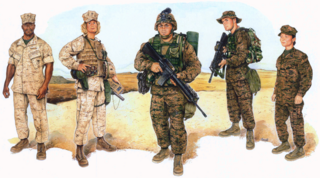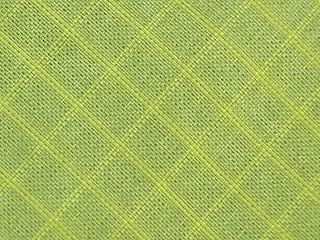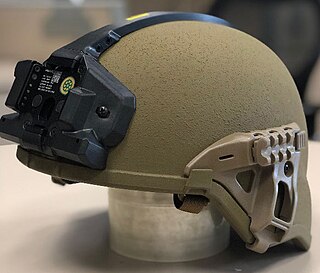
The Army Combat Uniform (ACU) is the current combat uniform worn by the United States Army, U.S. Air Force, and U.S. Space Force. Within U.S. Air Force and U.S. Space Force, it is referred to as the OCP Uniform, rather than the Army Combat Uniform.

A flight suit is a full-body garment, worn while flying aircraft such as military airplanes, gliders and helicopters. These suits are generally made to keep the wearer warm, as well as being practical, and durable. Its appearance is usually similar to a jumpsuit. A military flight suit may also show rank insignia. It is sometimes used by Special Forces as a combat uniform in close quarters battle or visit, board, search, and seizure situations, for its practicality.

Shoulder sleeve insignia (SSI) are distinctive cloth patches worn on the left sleeve of the United States Army uniform just below the shoulder seam by soldiers assigned to divisions, corps, armies, and other specifically authorized organizations. They are also worn on the right sleeve by soldiers to indicate former overseas service with certain units during periods of U.S. military operations in hostile conditions (MOHC).

The Airman Battle Uniform (ABU) is a U.S. camouflage combat uniform formerly worn by members of the United States Air Force, United States Space Force, and some civilian employees of the U.S. Department of the Air Force until April 2021. It replaced the Battle Dress Uniform and Desert Camouflage Uniform on 1 November 2011 after a four-year phase-in period.

The Advanced Combat Helmet (ACH) is the United States Army's current combat helmet, used since the early 2000s. It was developed by the United States Army Soldier Systems Center, the U.S. Army Special Operations Command, and the U.S. Army Research Laboratory to be the next generation of protective combat helmets for use by the American ground forces. The ACH is derived from the Modular Integrated Communications Helmet.

The Marine Corps Combat Utility Uniform (MCCUU) is the current battledress uniform of the United States Marine Corps. It is also worn by Navy personnel assigned to Marine Corps units.

The Improved Outer Tactical Vest (IOTV) is an enhanced version of, and a replacement for, the older Outer Tactical Vest (OTV) component of the Interceptor Multi-Threat Body Armor System, as fielded by the United States Army beginning in the mid-2000s. The IOTV is compatible with the Deltoid and Axillary Protector System (DAPS) components, ESAPI, Enhanced Side Ballistic Inserts (ESBI), as well as the OTV's groin protector. It has a flame-resistant standalone shirt, the Army Combat Shirt (ACS), designed specifically for use with the IOTV.
Flame Resistant Organizational Gear (FROG) is clothing used by the United States Marine Corps to reduce the number of injuries resulting from fire and flash, due to the increased use of improvised explosive devices in the wars in Afghanistan and Iraq.
The uniforms of the United States Army distinguish soldiers from other service members. U.S. Army uniform designs have historically been influenced by British and French military traditions, as well as contemporary U.S. civilian fashion trends. The two primary uniforms of the modern U.S. Army are the Army Combat Uniform, used in operational environments, and the Army Green Service Uniform, worn during everyday professional wear and during formal and ceremonial occasions that do not warrant the wear of the more formal blue service uniform.

Ripstop fabrics are woven fabrics, often made of nylon, using a reinforcing technique that makes them more resistant to tearing and ripping. During weaving, stronger reinforcement yarns are interwoven at regular intervals in a crosshatch pattern. The intervals are typically 5 to 8 millimeters. Thin and lightweight ripstop fabrics have a two-dimensional structure due to the thicker yarns being interwoven in thinner cloth. Older lightweight ripstop fabrics display the thicker interlocking thread patterns in the material quite prominently, but more modern weaving techniques make the ripstop threads less obvious. A similar effect can be achieved by weaving two or three fine yarns together at smaller intervals.
F-INSAS is India's programme to equip its infantry with state-of-the-art equipment, F-INSAS standing for Future Infantry Soldier As a System. However the Indian Army has decided to drop the F-INSAS program in favour of two separate projects. The new program will have two components: one to arm the future infantry soldier with the best available assault rifle, carbines and personal equipment, such as helmets and bulletproof vests. The second component is the Battlefield Management Systems (BMS).
The Army Combat Boot is the primary issue combat boot of the United States Army since 2002, intended for use in conjunction with the Army Combat Uniform. In 2015, the Army changed the color for the combat boot to a coyote brown color.

Propper is a manufacturer of clothing and gear for tactical, law enforcement, public safety, and military applications. Since 1967 it has been one of the main uniform suppliers to the United States military.

The Mounted Soldier System (MSS) or Ground Warrior is a combat vehicle crewman ensemble integrating advanced gear as an effective force multiplier in combat theater.

The Enhanced Combat Helmet (ECH) is a combat helmet designed in conjunction of a joint program of the United States Marine Corps and United States Army to replace the current combat helmets in use by the U.S. Army, Marines, Navy, and Air Force. Although similar in shape of the Advanced Combat Helmet and its predecessor the Modular Integrated Communications Helmet, the ECH is instead constructed using thermoplastics instead of the ballistic fibers used on previous-generation combat helmets.
TenCate Defender M is a flame-resistant fabric used by both the United States Army and Marine Corps as the uniform material for ground troops in Iraq and Afghanistan because of new war threats like improvised explosive devices (IEDs). The fabric has a proprietary blend of fibers which provides intrinsic flame-resistant qualities which protect soldiers from flame and high-temperature heat. Mike Sloane of PEO Soldier, the U.S. Army's acquisition organization, "The burn rate has gone down significantly. We find that the soldiers who were wearing flame-resistant uniforms have sustained nearly no burns."

Operational Camouflage Pattern (OCP), originally codenamed Scorpion W2, is a military camouflage pattern adopted in 2015 by the United States Army for use as the U.S. Army's main camouflage pattern on the Army Combat Uniform (ACU). This pattern officially replaced the U.S. Army's previous Universal Camouflage Pattern (UCP) as the official combat uniform pattern for most U.S. soldiers at the end of September 2019. The pattern also superseded the closely related MultiCam, a pattern previously used for troops deploying to Afghanistan.

The Integrated Head Protection System (IHPS) is the United States Army's newest combat helmet, intended to eventually replace the Advanced Combat Helmet and Enhanced Combat Helmet.













